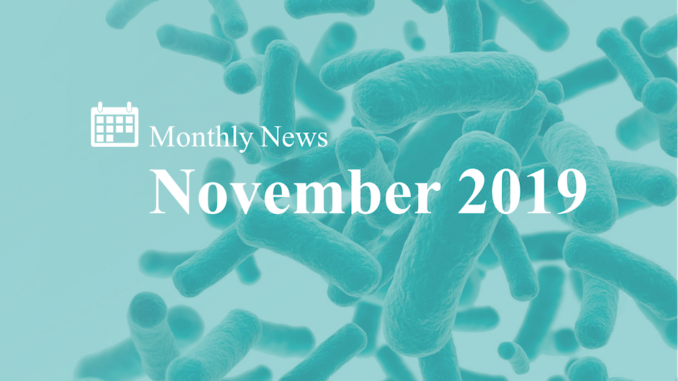
This month’s roundup begins with a paper describing what happens when bifidobacteria in the infant gut degrade human milk oligosaccharides; and another about the role of the infant airway microbiota in predicting later-life asthma. Next are studies on two different disease areas that implicate Enterococcus strains in the gut: graft-versus-host disease and alcoholic liver disease. This edition wraps up with a series of mouse experiments from Stanford researchers that investigate ever-germane issue of how the gut microbiota recovers after antibiotic perturbation.
Two great microbiome-related scientific events occurred virtually in the past few weeks: the first was a Virtual Keystone Symposium called “The Role of the Genital Tract Microbiome in Sexual and Reproductive Health.” Most of the discussion during this webinar centered around the vaginal microbiome and its connection with a variety of women’s health conditions, from HIV transmission to bacterial vaginosis, and even to miscarriage and preterm birth. See videos from the webinar here, or you can search #VKSgentract on Twitter to catch up on the main points.
The second event was a US National Science Foundation microbiome symposium, webcast from Washington DC and covered extensively on Twitter. Discussions aimed to (1) identify and prioritize major transformative biological questions for microbiome science, (2) develop priorities for theory development and/or testing for microbiome ecology and evolutionary biology, and (3) identify and prioritize specific gaps in technical, analytical, or educational capacities that if addressed will significantly advance understanding and applications in microbiome science. Check out the Twitter hashtag #NSFmicrobiomes for highlights.
Human milk oligosaccharides (HMOs) are known as “food for good bacteria” in the infant intestinal tract. But HMOs don’t just enable discrete strains of bifidobacteria to proliferate in the infant gut—rather, they delicately support an entire ecosystem of bacteria. This detailed work from Hall Lab showed how different strains of bifidobacteria collaborate to degrade HMOs, with each strain contributing according to what its genes equip it to do. The authors showed that when an HMO was metabolized by one species, the resulting metabolites led to the growth of another species that did not compete for the HMO substrate. In this way, HMOs influence bacterial growth dynamics and ‘manage’ the infant gut ecosystem.
Infant airway microbiota and topical immune perturbations in the origins of childhood asthma
Several studies from the past few years have identified patterns of bacteria in the guts of infants that are associated with the development of asthma in early childhood—say, by age three or five. But what about the microbiota of the respiratory tract? In this paper, researchers examined a 700-child cohort and found that increased microbial diversity and altered composition of the airway microbiota at one month predicted asthma by age six. The airway abundance of Veillonellawas most strongly associated with the later development of asthma. Furthermore, airway immune profiles were found to be abnormal in the kids who would get asthma by the age of six. Possibly both gut and lung microbiota could turn out to provide important predictive information on the development of asthma in early childhood.
Lactose drives Enterococcus expansion to promote graft-versus-host disease
Complications often occur after allogeneic hematopoietic cell transplantation (allo-HCT), and previous work suggests these complications—including graft-versus-host disease (GVHD) or even death—might have something to do with the gut microbiota. A group of researchers looked closely at gut microbiota and the occurrence of allo-HCT complications: and interestingly, the path led back to diet. Firstly, in a cohort of 1300 individuals, they found that Enterococcusin the gut were associated with graft-versus-host disease (GVHD) incidence and mortality. In a mouse model, too, the Enterococcusstrains bloomed after allo-HCT. Interestingly, in the mice these bacteria seemed to depend on dietary lactose for expansion. So the researchers turned back to the human cohort and found that patients treated with allo-HCT who had a lactose-nonabsorber genotype were the ones with a greater abundance of the bad-news Enterococcus. Overall, this emerging story shows that dietary factors may lead to the (over)growth of commensal gut bacteria, which may play a role in disease complications.
Bacteriophage targeting of gut bacterium attenuates alcoholic liver disease
An altered gut microbiota composition is associated with various forms of liver disease, but we know relatively little about the gut microbiota specifically implicated in alcohol-related liver disease. This recent work pinpointed a toxin in the gut, secreted by gut bacteria, which appears to cause liver damage. That is: in people with alcohol-related liver disease, disease severity and mortality appeared to correlate with Enterococcus faecalisthat secreted cytolysin. The investigators went further by showing in a humanized mouse model that bacteriophages targeting E. faecaliswere able to protect the host from the alcohol-induced liver damage it might have suffered. This leaves open the possibility to test in humans whether phage therapy can prevent alcohol-related liver disease through ‘precision editing’ of the gut microbiota.
Human gut microbiotas differ in their response to antibiotics. Through a series of highly-controlled experiments using human microbiotas transplanted into mice, a group of researchers sought to answer: how do environmental factors contribute to gut microbiota resilience after antibiotics? First, the good news: human microbiotas generally showed a rapid recovery after perturbation by antibiotics. But the bad news: a diet low in microbiota-accessible carbohydrates (basically, fiber) delayed gut microbiota recovery. In addition, something as simple as exposing mice to additional environmental microbes through cross-housing made the gut microbiota more resilient to multiple antibiotic treatments. According to the authors, “Our findings paint the picture of a microbial community that bends with global shifts in diet, antibiotics, and composition yet exhibits resilience if the community can be reinforced through environment-mediated recolonization.”

